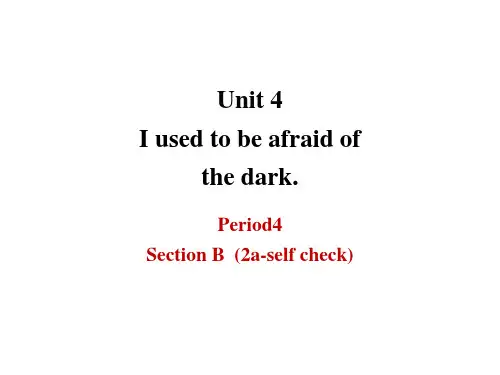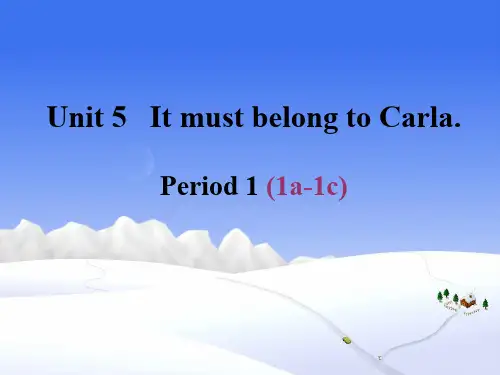新目标九年级英语UNTI5Section B 第5课时
- 格式:ppt
- 大小:1.32 MB
- 文档页数:35
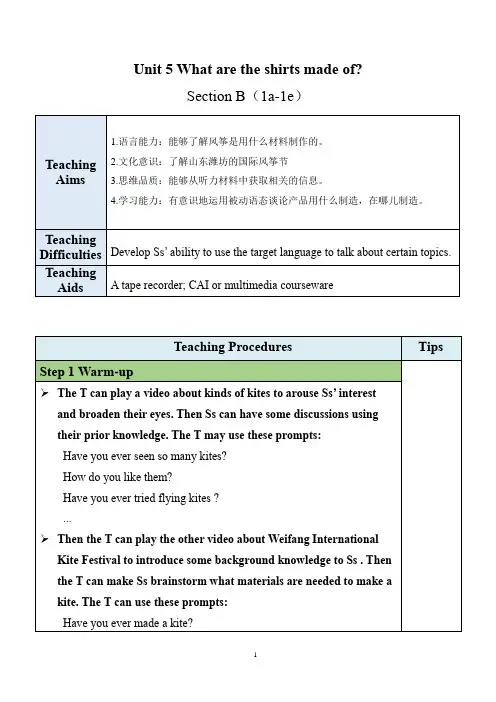
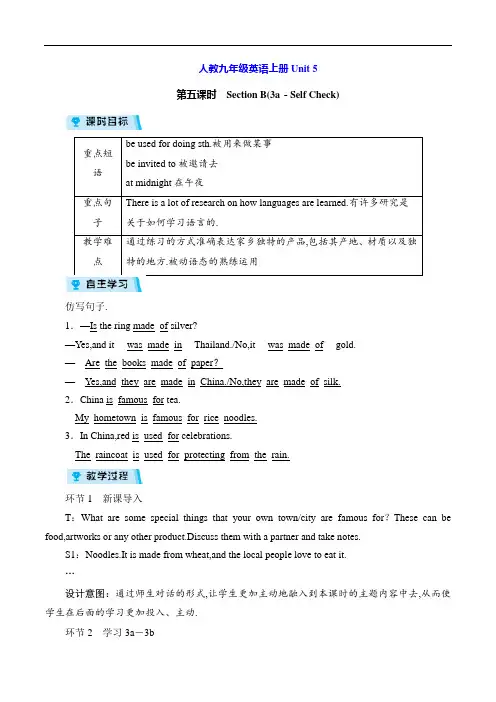
人教九年级英语上册Unit 5第五课时Section B(3a-Self Check)重点短语be used for doing sth.被用来做某事be invited to被邀请去at midnight在午夜重点句子There is a lot of research on how languages are learned.有许多研究是关于如何学习语言的.教学难点通过练习的方式准确表达家乡独特的产品,包括其产地、材质以及独特的地方.被动语态的熟练运用仿写句子.1.—Is the ring made_of silver?—Yes,and it __was_made_in__ Thailand./No,it __was_made_of__ gold.—__Are_the_books_made_of_paper?__—__Yes,and_they_are_made_in_China./No,they_are_made_of_silk.__2.China is_famous_for tea.__My_hometown_is_famous_for_rice_noodles.__3.In China,red is_used_for celebrations.__The_raincoat_is_used_for_protecting_from_the_rain.__环节1新课导入T:What are some special things that your own town/city are famous for?These can be food,artworks or any other product.Discuss them with a partner and take notes.S1:Noodles.It is made from wheat,and the local people love to eat it.…设计意图:通过师生对话的形式,让学生更加主动地融入到本课时的主题内容中去,从而使学生在后面的学习更加投入、主动.环节2学习3a-3b1.老师以对话的形式和学生交流问题“Do you know the most famous or any special things in you town/country?”,学生进行讨论并回答.2.按照3a表格中提示的问题,完成表格,完成之后,让学生们进行对话交流,并抽选一两位学生在课堂上进行展示.3.老师对3b中提炼的句子进行讲解,讲授关于写家乡独特的东西或产品的写作技巧.4.让学生根据3a中的笔记和3b所提供的句式完成短文写作.5.老师评阅作文之后进行优秀作文的展示.设计意图:采用由点到面的策略,先从相关问题的回答再到句子的陈述,然后把多个句子组成一个文段,由浅入深地学习了有关家乡独特东西的作文.环节3学习Self Check1.在1中表格列出你每天需要用到的东西,并写下他制成材料和产地.学生之间可相互讨论.2.将1中填好的表格信息写出五个完整的句子,写好之后抽选几位学生进行展示.3.完成3中的练习,老师进行讲解,并加深对被动语态的学习.4.学以致用.(根据汉语意思完成句子,一空一词)(1)你的手套应该是皮制的,因为它摸起来柔软光滑.Your gloves should __be__ __made__ __of__ leather,for they feel soft and smooth.(2)J.K.罗琳写的书受到全世界孩子们的喜爱.The books written by J.K.Rowling __are__ __loved__ by children all over the world.(3)坚持努力学习,你将会梦想成真.Keep studying hard,and your dream __will__ __be/become/come__ __realized/achieved/ true__.(4)许多人相信大约在5000年前茶第一次在中国饮用.Many people believe that tea __was__ __drunk__ first in China about 5 000 years ago.(5)“你的卧室非常干净.”“当然,每天都要打扫它.”—Your bedroom is so clean.—Of course.It __is__ __cleaned__ (clean) every day设计意图:通过对日常用品的练习,加深对被动语态的学习,学以致用的题目意在检测学生对语法的掌握程度.Unit 5 What are the shirts made of?Section B(3a-Self Check)My town/city is famous/known for... ...is famous in my town/city....is/are made of/from/with/by/in... ...is/are used for... ...is/are known for... ...is/are special because...请完成本课对应训练!。
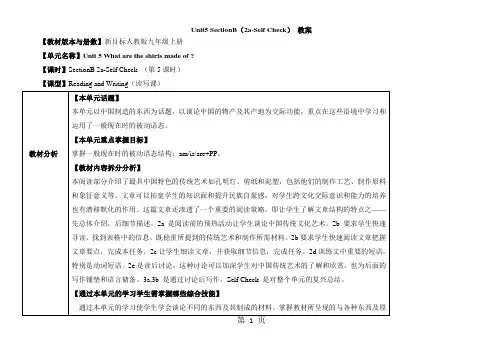
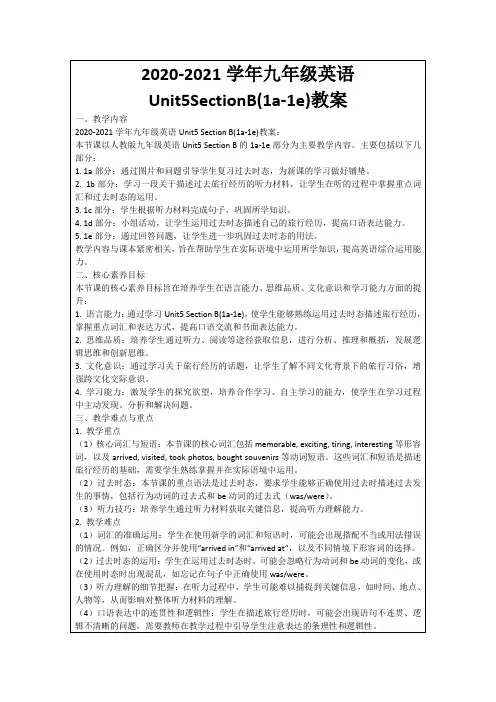
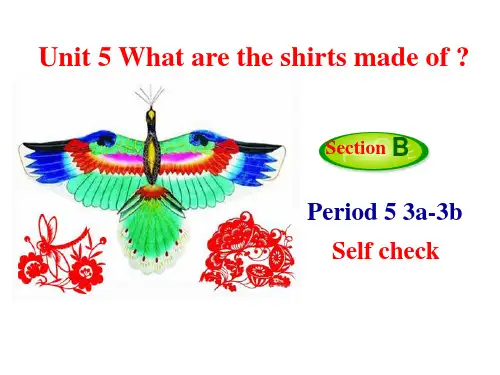
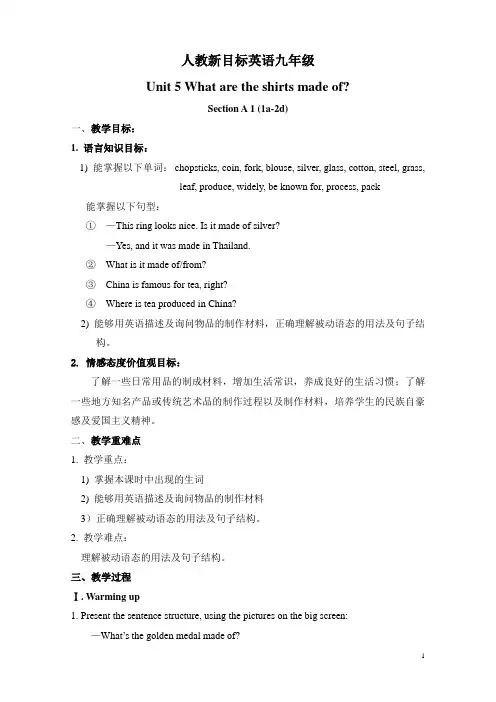
人教新目标英语九年级Unit 5 What are the shirts made of?Section A 1 (1a-2d)一、教学目标:1. 语言知识目标:1) 能掌握以下单词:chopsticks, coin, fork, blouse, silver, glass, cotton, steel, grass,leaf, produce, widely, be known for, process, pack 能掌握以下句型:①—This ring looks nice. Is it made of silver?—Yes, and it was made in Thailand.②What is it made of/from?③China is famous for tea, right?④Where is tea produced in China?2) 能够用英语描述及询问物品的制作材料,正确理解被动语态的用法及句子结构。
2. 情感态度价值观目标:了解一些日常用品的制成材料,增加生活常识,养成良好的生活习惯;了解一些地方知名产品或传统艺术品的制作过程以及制作材料,培养学生的民族自豪感及爱国主义精神。
二、教学重难点1. 教学重点:1) 掌握本课时中出现的生词2) 能够用英语描述及询问物品的制作材料3)正确理解被动语态的用法及句子结构。
2. 教学难点:理解被动语态的用法及句子结构。
三、教学过程Ⅰ. Warming up1. Present the sentence structure, using the pictures on the big screen:—What’s the golden medal made of?—It’s made of gold.—Is this table made of wood?—No, it isn’t. It’s made of glass.—Is Butter made from meat?—No. It’s made from milk.II. Presentation1. Show some pictures on the big screen. Try to learn the new words using “be made of”structure.Learn the new words: chopsticks, coin, fork, blouse, silver, glass, cotton, steel, grass, leaf2. Ss discuss with their partner and try to learn the new words.3. Give Ss five more minutes to remember the new words.4. Work on 1a:Let Ss read the things and materials in 1a. Discuss with their partners and match them with the materials. More than one answer is possible.What are these things usually made of? Match them with the materials. More than one answer is possible.Check the answers with the Ss.III. Listening1.T: Tell Ss they will hear a conversation about some things and material. Listen andmatch the products with what they are made of and where they were made.2. Let one student read the words in the box, Play the recording for the Ss to listen.3. Ss try to listen and match the things with the material and here they were made.4. Play the recording again. Let Ss answer the questions.1) How much did Susan pay for the three shirts?29 dollars.2) What does Anita feel about the three shirts?Cheap.3) What are the shirts made of?Cotton.4) Where were they made?America.5) Where did Susan buy the chopsticks?Korea.6) How does Anita like the chopsticks?Cool.7) What else does Susan show?Ring.8) Where was the ring made?Thailand.9) What will Susan do with the ring?She give it to her friend.IV. Pair work1. Read the conversation in the box in 1c.2. Ss try to made conversations using the information in 1b.e.g. A: Your new shirt looks very nice. Is it made of cotton?B: No, it isn’t. It’s made of silk.3. Let some pairs read out their conversations.V. ListeningPre-listeningfair adj. 公平的; 合理的; 美丽的fair n. an event at which people orbusinesses show and sell productsa book faira trade fairWork on 2a:T: Let’s listen to another conversation between Nick and Marcus.1. What are they talking about? First, let’s look at the pictures and the phrases in 1a.(Let one students read the phrases in 2a.)Listen and check ( √) the main topic of Nick and Marcus’ conversation.____ the science museum____ the art and science fair____ environmental protection____ a model plane____ a beautiful painting____ grass and leaves2. Play the recording for the Ss to listen and check the phrases.3. Play the recording again to check the answers.Work on 2b:1. Let Ss read the sentences below. Explain some main sentences for the Ss. Make sure they know what to do.2. Let Ss read the questions in 2b. Make sure they understand the meaning of each question.Play the recording for the Ss to answer the questions. (If necessary, using the pause button.)1) Where is the art and science fair?_________________________2) Do Nick and Marcus have to pay to go?_________________________3) What is the model plane made of?_________________________4) What is the painting made from?__________________________3. Play the recording again and mark true or false.1) The art and science fair is just inside the science museum.2) The fair is mainly about planes and paintings.3) All the works at the fair were made by university students.4) The model plane is very big.5) The painting is made of wool and grass.6) The students are asked to pay for the art and science fair.7) The students are interested in environmental protection and recycling.VI. Pair work1. Tell Ss to make a conversation using the information in 2a and 2b.e.g.A: What did you see at the art and science fair?B: I saw a model plane.A: What is it made of?B: It’s made of steel, glass, and plastic.2. Let Ss make their own conversations.3. Practice their conversations in pairs.VII. Role-play1. Work on 2dRead the conversation and complete the blanks.1) Chinese _____________ tea both in the past and now.2) _________ I know, tea plants _________ on the sides of mountains.3) When the leaves are ready, they _______ by hand and then _______ for processing.4) The tea ____________ and sent to many different countries and places around China.5) People say that tea ___________ ____ health _____ business!2. Read the conversations and Let Ss read after the teacher.3. Ask Ss to role-play the conversation in groups.VIII. Language points1. What is the model plane made of?What is the painting made from?be made of与be made from 辨析两词组都是“由……制成的”之意。
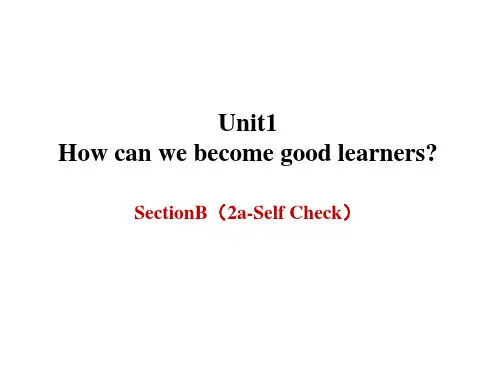
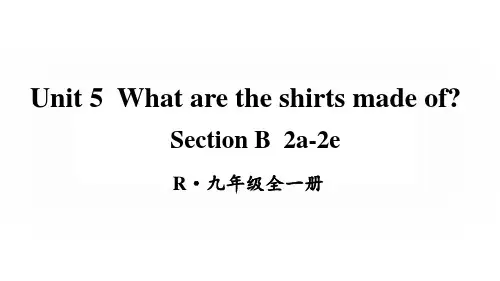

Period 5 Section B 3a - Self Check【知识与能力目标】1) 复习一般过去时态被动语态的用法。
2) 能够用英语讲述自己所熟悉的某一发明的简单过程。
3) 能用就本单元所学习的寓言故事等语言材料, 进行完型填空。
并用英语介绍某一发明的简要过程。
【过程与方法目标】本课的任务型语言教学中,我将依据课程的总体目标并结合教学内容,创造性地设计贴近学生生活实际的任务活动,吸引和组织他们积极参与,使学生通过观察、思考、讨论、交流和合作等方式,在一种自然、真实或模拟真实的情境中体会语言、掌握语言的应用。
【情感态度价值观目标】了解世界上一些对人类有着重大意义的发明的相关信息,开阔学生的眼界,养成勤于思考,善于发现的好习惯,培养学生的创造精神。
【教学重点】1)用英语介绍某一发明的简要过程。
2)掌握本单元所学的词汇、句型及语法知识,并能进行综合练习运用。
3)完成Self check部分的练习试题。
【教学难点】用英语介绍某一发明的简要过程。
Step 1. Revision1. Review the expressions and sentences in Section B 1.2. Check the homework.Let Ss introduce the history of basketball.Step 2. Lead in1. Ask Ss which invention they like best.Ss think about their favorite inventions.2. Let some Ss talk about their favorite inventions.Step 3. Discussion (3a)1. Ask Ss what things they don’t like to do.e.g. Problem: quickly taking notes in class.2. Discuss in group and think of an invention that could help you.e.g. New invention: a special penWhat it is used for:taking notes quickly in class3. Ss discussing the problems and try to make their own notes.4. Let some Ss read their notes to the class.Step 4. WritingWork on 3b:1. Tell Ss to write a description of your new invention.2. The following sentence structure may help you.常用句型:① I think … is a very useful invention. 我认为……是一项很有用的发明。
